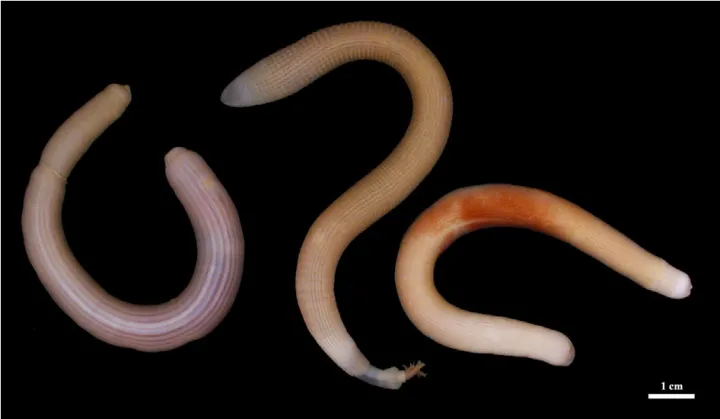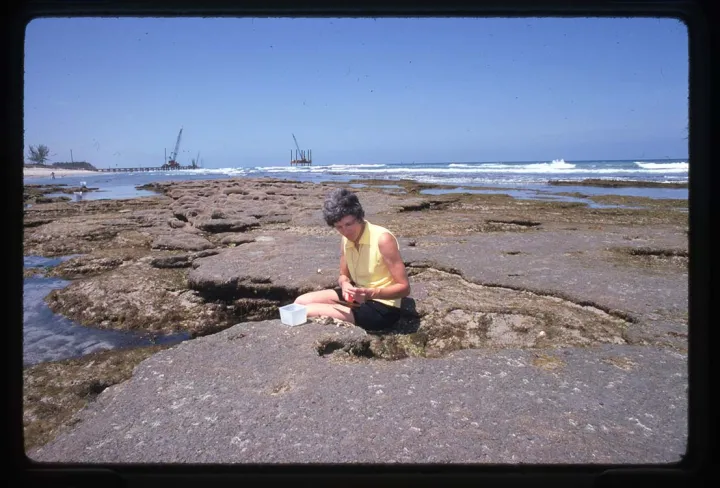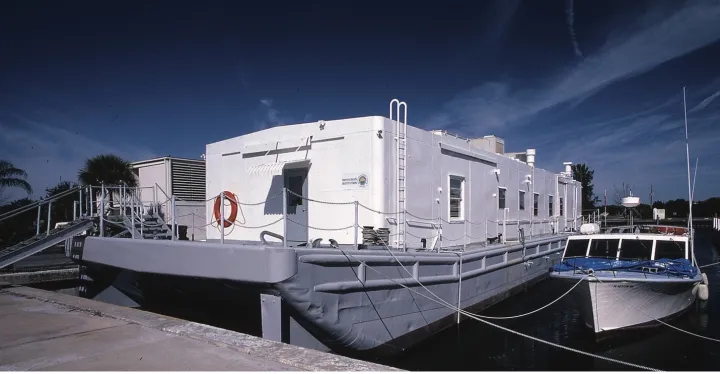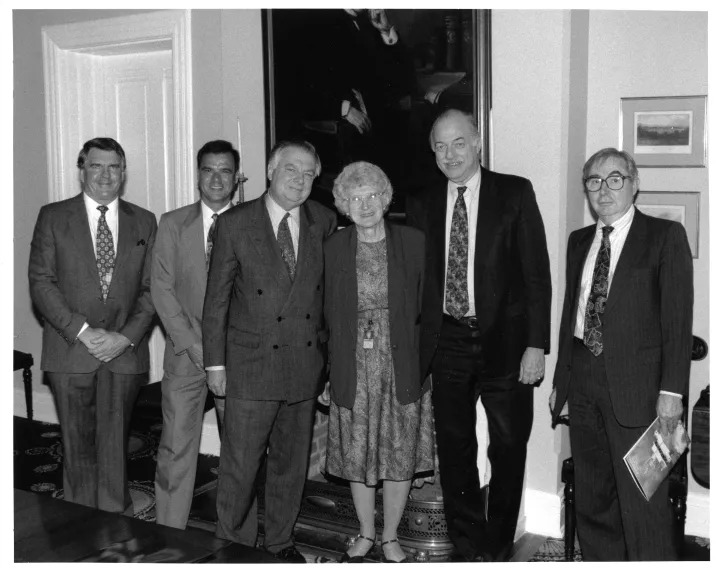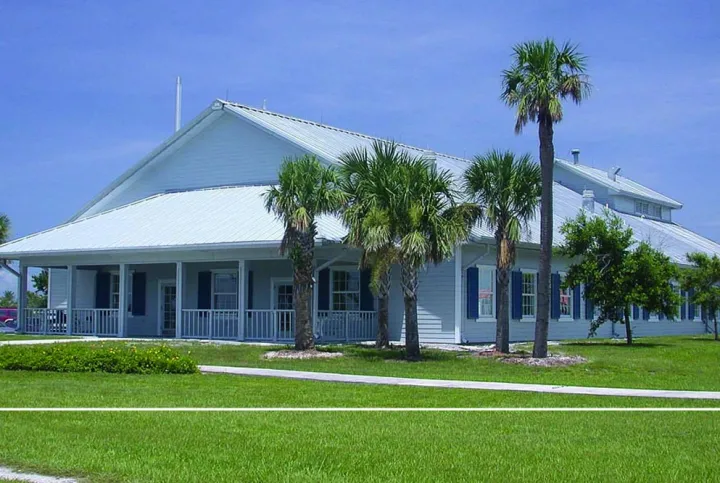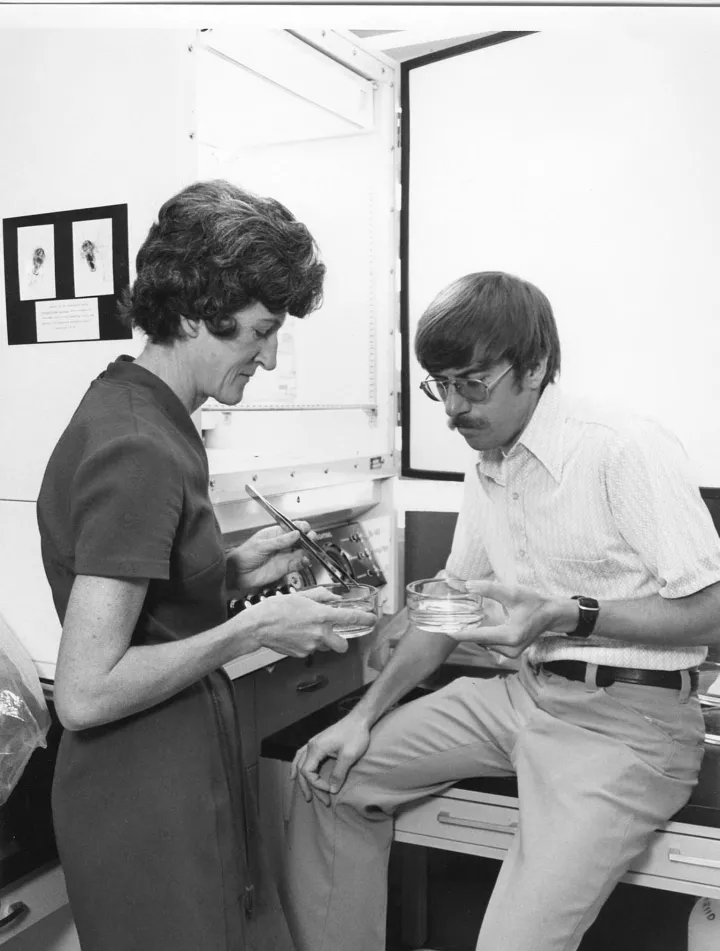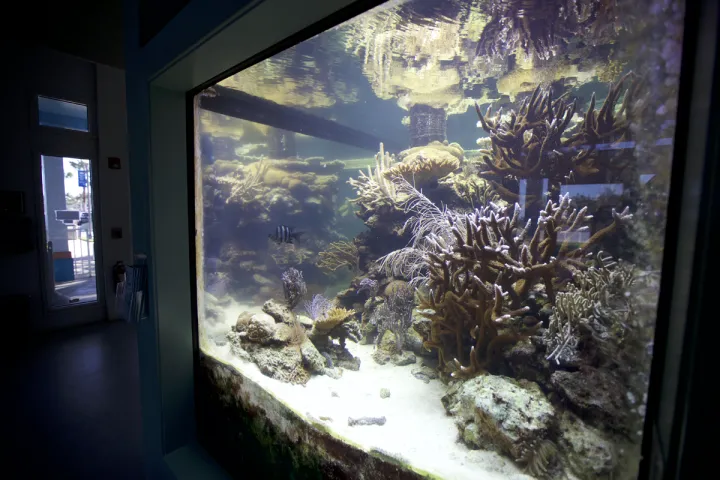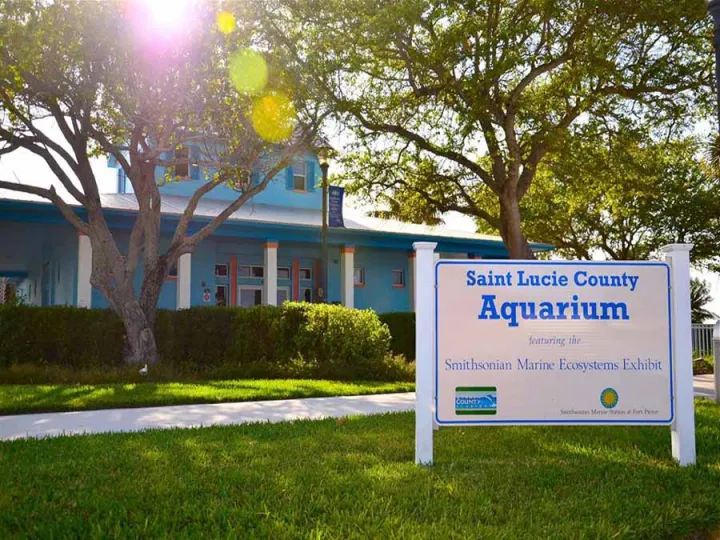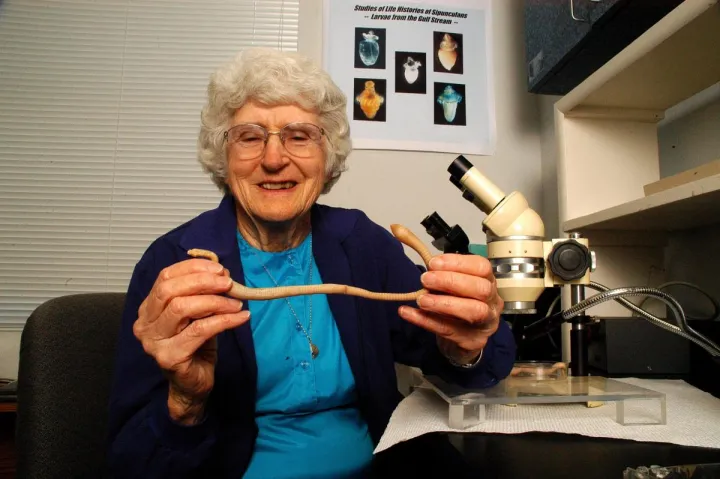Mary Rice: A Force of Nature
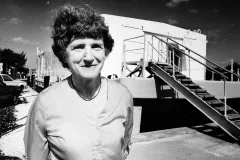
Dr. Mary Esther Rice spent her career pushing back against obstacles and refusing to take no for an answer.
Dr. Valerie Paul, the current director of the Smithsonian Marine Station in Fort Pierce, comments on her relationship with Dr. Mary Rice and how she served as a mentor for her as she acclimated to her new role.
A Lifetime of Resolve
One of just five female curators in the entire National Museum of Natural History when she joined in 1966, Dr. Mary Rice went on to develop an extraordinary legacy. She was a foundational figure in an emerging scientific discipline—evolutionary development—and labored tirelessly toward the creation of the Smithsonian Marine Station in Fort Pierce, Florida.
When she passed away at the age of 94 on April 29, 2021, colleagues and friends around the world saluted her long life and career, and celebrated her grit and resolve.
“She was a very forthright person,” said Dr. Dave Pawson, former Acting Director of the National Museum of Natural History and close friend. “She didn’t mince words. You knew pretty quickly once you met her that she didn’t suffer fools gladly.”
“She was somebody you didn’t want to mess with,” said Dr. Kevin Eckelbarger, former director of the Darling Marine Center at the University of Maine and a long-time colleague and friend of Rice’s.
An immensely determined woman, Rice seemed to ignore obstacles that were typical for women in science at the time.
“I think the men kind of resented us,” Rice said in a 2010 oral history interview with Smithsonian archivist Pamela Henson, recalling her experience as a woman in science during college. “But we seemed to get along all right.”
Her commitment remained a steady aspect of her character all throughout her life. Her ambition and dedication would become a force that changed a scientific field, and the Smithsonian itself.
From Farm to Fieldwork
Rice began her life in Washington, D.C., where she was born on August 3, 1926. She spent her formative years on a farm in southern Maryland, playing with farm animals and her two siblings, and crabbing and fishing on the nearby Chesapeake Bay. She credited her interest in nature with those early experiences; by the age of 12, she’d acquired her first microscope and determined her future would be in biology.
She was also an enthusiastic visitor to the Smithsonian as a youngster: visiting her father at work at the Treasury Department, she’d make forays over to the National Museum of Natural History where she was fascinated by an exhibit about horse evolution—a foreshadowing of her future scientific pursuits.
Rice studied biology at Drew University beginning in 1943—the first year the college admitted women into its programs. During her undergraduate years, she had the opportunity to take courses at the Marine Biological Laboratory at Woods Hole, Massachusetts, which she said was a critical turning point in her academic career. There she discovered marine invertebrates—slow-moving creatures, easy to observe in a laboratory setting. She graduated magna cum laude from Drew in 1947.
After completing a master’s degree in zoology at Oberlin College, she began work as a research associate in radiology at Columbia University in New York. In 1961, at 35 years old, Rice decided a shift was in order—she packed up her car and drove to the Pacific coast to begin a PhD program to study a very obscure set of creatures: sipunculan worms.
Oblong, putty-colored, and lumpy, “peanut worms” captured Rice’s interest for several reasons— their relationship to other marine organisms was poorly understood, and their larval development could vary wildly. Though outwardly they look like annelids (typical earthworms), whether sipunculans should be classed with annelids or mollusks is still a matter of hot debate. By comparing the growth and development of larval sipunculans with segmented worms, scientists like Rice sought to better understand the emergence and early evolution of higher-order animals such as vertebrates.
At the University of Washington in Seattle, Rice studied their developmental processes, specifically focusing on their growth from larva to adult, along with their reproductive processes, and their evolution. Her interest intensified during a yearlong cruise to the south Pacific on the Te Vega, a Stanford University research schooner. Despite seasickness, fires, and explosions aboard the boat, and being only one of two women, the experience gave Rice invaluable experience in tropical biology. Several specimens collected from that cruise now reside in the collections of the National Museum of Natural History.
Dream on the Florida Coast
Following her studies in Seattle, Rice arrived at the National Museum of Natural History in 1966, a time when there was an increased interest in research. Joining the Department of Invertebrate Zoology as its second-ever female curator, Rice split her time managing outside requests from researchers and laying plans to begin her own research program.
Since the temperate waters of the Mid-Atlantic lacked the organisms she studied, Rice was able to find funding for tools and travel to the Caribbean and Venezuela, where she collected specimens for study and for the museum’s collections. In 1971, she visited Florida and learned of a connection between the Smithsonian and the Harbor Branch Foundation, which was building a research laboratory near Fort Pierce, Florida. In a stroke of fortune, Rice was invited by a colleague at the museum who was assisting with the development of the Harbor Branch lab, Gene Wallen, to make a “dream sheet” of tools, instruments, and even a research assistant, and take up residence for research once the lab was complete.
“I thought, well, this doesn’t happen in the real world,” she told Henson in the 2010 interview. “But why not spend two weeks sitting down, making my list? I don’t have a lot to lose.”
In January 1972, she stepped into her new research space at Harbor Branch for the first time.
“The microscopes of my dreams were what I had ordered,” she said. “And there they were.”
Despite the fairytale beginnings, Rice eventually saw the need for an independent Smithsonian Marine Station—one that could be a resource for other Smithsonian and visiting scientists interested in doing fieldwork in Florida. She reflected, “I felt that being there in Fort Pierce, I could do a great deal for the museum, probably even more than being in Washington, because I was in a position to make resources available for museum scientists to work there.”
With that goal in mind, Rice knew how to garner support. She would invite curators from the National Museum of Natural History in Washington, DC to come down to Florida and conduct fieldwork from her Harbor Branch lab. She would set them up with all the materials they needed for their research, and ensure they made progress on their work, all while having a great time down in sunny Florida. As they left to return to D.C., all Rice asked in return was that they would put in a good word for her when her name came up, with the hope of eventually gaining endorsement for her plans.
“I admit, she bribed them, there’s no question.,” Eckelbarger quipped. “She gave them wonderful services.”
Knowing she had gained support from other Smithsonian scientists, Rice repeatedly traveled from her lab in Florida to the Smithsonian in Washington, to see what headway she could make toward her goal. On multiple occasions, with arms full of plans and sketches, Rice marched into the Smithsonian Castle up to the office of the Undersecretary for Science, where she would petition the leadership for support on her dream of developing a Smithsonian marine station.
“She had a vision for that marine station, and she was going to do it whether people liked it or not,” Eckelbarger said.
In 1981, Rice prevailed. She received all the necessary approvals to found the Smithsonian Marine Station, which she operated out of Harbor Branch. The floating lab aboard a surplus barge quickly outgrew its space, though. She wanted to relocate, and battled space constraints, land issues, and politics, until finally her continued persistence paid off: a spacious, well-equipped facility opened its doors nearby in Fort Pierce in 1999.
A testament to her tenacity, Rice successfully founded and developed one of only about 200 marine stations in the world—and one of very few founded by just one person.
Open Doors
Rice directed research at the marine station until 2002 when she retired. Though the station’s facilities and convenient location near the Gulf Stream and a diverse estuary ecosystem made the station an invaluable addition to the Smithsonian’s capabilities, it was Rice’s open-door policy that really drove the facility’s success.
The Life Histories Program invited visiting scientists to the Smithsonian Marine Station to study the life cycles of marine animals in their natural habitats. Under Rice’s direction, the program developed into a robust, collaborative initiative that welcomed researchers of every stripe, where they could do work right on the water, impossible at most other locations. Scientists were virtually breaking down the door to participate.
This program, along with the resources available to her at the Marine station, enabled Rice to help develop a new scientific field—evolutionary developmental biology—or evo-devo for short. Evo-devo, the comparative study of organisms’ developmental processes to determine evolutionary relationships, relied on the usage of new technologies and approaches of molecular genetics. As this process became accessible, Rice ensured the Smithsonian Marine Station stayed ahead of the curve.
Her continued support of scientists of all research interests “enriched [her] whole outlook on developmental biology and on the kinds of research that were done” at the time. These studies “formed the basis for a lot of the work” that was then being done in evo-devo, she explained.
Reaching Out
As a liaison between the National Museum of Natural History in D.C. and the Smithsonian Marine Station in Fort Pierce, Rice actively participated in both communities, finding ways to benefit both. She understood the Fort Pierce community’s interest in having a public aquarium; as an oceanfront community, both the general public and local students could learn about the area’s marine ecosystems.
Auspiciously, during a visit to Washington, she learned of a coral reef exhibit that was in need of a new home.
“The light went on, and I said, ‘That’s just what we need in Fort Pierce,’” she recalled.
She returned to Fort Pierce and met with St. Lucie County administrators. She told them of the existence of the exhibit, but informed them that the Marine Station had no space or funding to support it. Fortunately, it all came together: she recalled, “they said, ‘If you bring that exhibit down here and you take care of the exhibit, manage the exhibit, we will build you a building to put it in.’”
Negotiating an agreement between the Smithsonian and St. Lucie County, Rice spearheaded the transplant, installation, and maintenance of the 3,000-gallon saltwater exhibit from Washington D.C. to Fort Pierce. In doing so, she helped develop the St. Lucie County Aquarium—with this exhibit still as its central showpiece and largest draw for visitors.
A Legacy Built on Determination
After her retirement in 2002, Rice continued research right up to the time of her death in 2021. Though diminutive in stature, Rice proved to be a formidable force over the six decades of her remarkable career.
Friends and colleagues saluted her as much for her steadfast research passion as for her warmth and compassion. She was an impressive scientist who made a significant difference in the lives of other scientists and in her field.
Upon her death, tributes poured in from around the world on the Museum's Facebook page from scientists of all ages and backgrounds who said their lives were changed by her influence.
“She was a tough mentor that paved the wave for many scientists, male and female. I am saddened to hear this news, but she lived a life to be celebrated. She was a force of nature.”
With contributions from Michelle Z. Donahue and Danielle Hall


